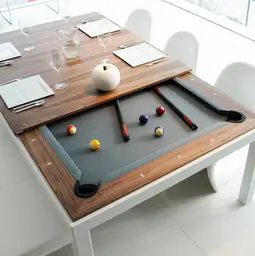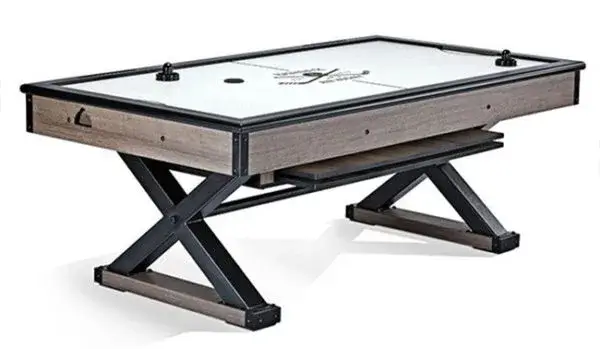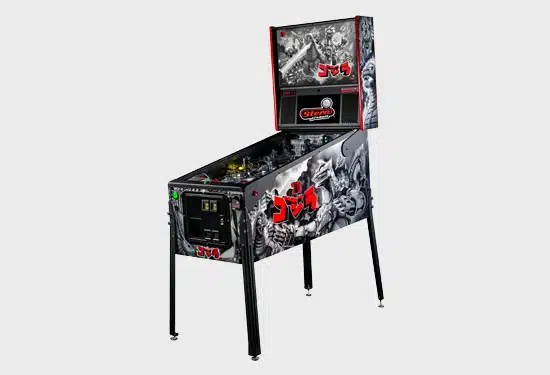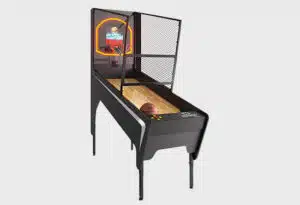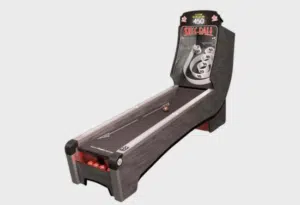Playing Darts
Playing darts is a great way to pass the time with good friends and good laughs.While there are many variations of games played with a dartboard, the most well-known game is for each player to start with an number of points ending in “01” (e.g. 301, 501, 1001).The game of “01” is the classic game of Darts, played world-wide. The “01” refers to the fact that the game is played from a certain number of points, always ending in “01”. For example, the common tournament game of 501 (pronounced “Five-Oh-One”), is played from 501 points. Other variations are 301, 601, 801, 1001. The higher point games are usually played by teams.
The object of the game is simple… each player starts with the same score (501, for example) and the first to reduce his score to zero wins.
Players take turns throwing three darts each and subtract all points scored from their own beginning score (501). Each player removes his darts and marks his score before the opponent throws. Darts that bounce off or miss the board do not score and cannot be rethrown that turn.The difficult part of the game lies in the finish, known as “going-out”. To win, you must reach zero before your opponent, but you must also reach exactly zero, and the dart that brings the score down to zero must be a double. Doubles consist of the numbers in the outside narrow scoring band and the center (small) bullseye which counts as 50 points and is an actual double of the outer 25-point bull.
For instance, if you have 2 points left, you must hit a double-1 to bring the score down to zero. From 18 points, a double-9 would work. If you have an odd number left (a number that cannot be divided by 2), then darts must be thrown to reduce the score to an even number, before throwing at a double. For instance, there is no possible double out from 19, so a way to finish would be to throw a single-3 first, reducing the score to 16. The 16 can then be “taken-out” by throwing a double-8.
The games of 501, 601, 801, 1001, etc. are all played the same way, except for starting with more points. The game of 301 is different, however. Because of the potential for a very short game, 301 has an added difficulty…the game must start with a double. That is, each player must hit a double (any double) to start scoring. Each players scoring begins with the score of the first dart that hits a double.
Throwing Tips & Bad Habits to Avoid
There are a number of basics to keep in-mind, including several bad habits that you should avoid:
A steady Stance is very important. Don’t lean way over the line to get closer to the board. This one is a tough habit for some people to beat, but try.. as leaning robs the darter of stability. The feet and legs should be positioned in a solid, comfortable, and relaxed stance, with weight distributed to both feet. Excessive leaning places nearly all of the body weight on one foot, tiring the shooter in long matches and damaging accuracy in the short run.
The few inches gained by leaning over the line are simply not worth the huge loss of balance and stability. Plus, leaning lowers the shoulder, forcing one to throw upwards, fighting gravity. Leaning also usually means tensing the major muscles of the body to preserve balance. This often results in a jerky release and poor follow-through, since the body is already off-balance.
A number of long-time players report back, knee, ankle, and foot pain, from spending many years standing on one foot while playing darts. Even in the short run, leaning to throw will cause minor pain in the small of the back. Especially for older players, a firm stance will stop this discomfort, both while playing and the next morning!
Think about it..
In what other sport would you drink a few beers, try to stand balanced “tiptoe” on one foot, and then try to consistently hit a small target with a sharp pointed object?
In EVERY competitive sport, Accuracy begins with a Solid Stance!
Keep your feet planted solidly on the floor, and avoid lunging, rocking, or lifting the back foot off the floor during the dart toss.
This is often done in an attempt to get a harder throw.
The dartboard really does not care how hard you throw the dart! The only important thing is how accurately you throw it.!
Even a light throw, if accompanied by a smooth and extended follow-through, will easily reach the dart board and score.
Such wasted motion can really be a bad habit, as it affects the entire body and throw. Lifting the foot even partway from the floor deprives the body of good balance during the crucial moment of follow-through. The strength required to reach the board with any normal dart is minimal, and for best accuracy should be provided only by the fingers, wrist, and forearm. After the dart leaves your hand, let your hand and arm continue on towards the dartboard, ending with full extension, and the fingers pointing at the target.Imagine that you are bowling.. after letting go of the ball, you still must follow-through! The same applies to Golf, Billiards, Basketball, and most every other sport. Follow-through after realeasing the dart, ending up with your fingers fully extended, as though touching the spot that you want to hit.
Missing the board or hitting too low often cause beginners to think that more power is needed. This is rarely true, as one can tell by the fact that the missed darts usually hit hard enough to stick in the wall, which is quite a bit harder than a bristle dartboard. The problem lies with the accuracy of the throw and follow through. Even small children can be taught to throw accurately without lunging or using the shoulders in a throw.
If you feel short of power, stand upright, and keep your elbow up. The upper arm should be approximately parallel to the ground. This allows you to bring your arm back further, without hitting yourself in the face with the dart!
Stand Straight, Elbow Up, and you will effectively double the power of your throw without any extra effort. For one thing, the dart is much higher than when leaning, so gravity does much of the work for you.
The dart should be held in a level position, and maintain as level a stroke as possible. Don’t hold the dart sideways, or in any other position than level and pointed at the board. Skill at darts, or any other target sport, means being able to perform the same motion exactly the same way, time after time.Common sense, as well of years of studies in other sports, show that all non-essential motion should be avoided and discarded from the darter’s routine.
In Darts, this means that if the dart is to strike the board at a level attitude (nearly always the best), it should be held and thrown from a position as close to level as is possible.
Any other position (such as dart point-up, dart point-down, or sideways) means extra motion of all the hand and wrist muscles to correct the initial starting position. Pure wasted effort… and usually futile, since the dart will likely leave the hand at an angle and wobble all the way to the board.
The correcting motion needed to get the dart pointed back at the dartbaord imparts inertia to the dart’s mass, away from the direction of the target. Then the darts will often stick in the board at odd directions. After a long period of play, when concentration starts to slip a little, this can really be obvious, with darts hitting at all sorts of different angles.
Instead of “throwing” the darts, instead just gently “place” them in the dartboard with a smooth motion of your hand & fingers. Throwing like a baseball is unnecessary and even dangerous, as a dart thrown too hard may hit a wire or other object and bounce clear across the room to hit someone. Dartboard wires get bent and the bristles crushed from this type of abuse.
Fortunately, “baseball throwers” usually stop after a while, either due to the laughter of spectators or the frowns of the darts bar manager. This method is also hopelessly inaccurate, as all of the major strength muscles and very few of the fine control muscles are used. A dart should never be thrown so hard that the front of the dart barrel touches the bristles. If this happens when a dart is thrown normally, then the dart’s point is too short and should be changed at a darts shop.
Avoid Spinning the dart as you release it to add stability. Spinning the dart is often done inadvertently, and is a symptom of uneven release, usually a side effect of wrapping fingers OVER the dart, which then forces the dart to roll off the fingers on release. Instead, grip a dart gently from the sides, so that it easily flies free upon opening the fingers.
All parts of the hand should leave the dart at nearly the same time to ensure level flight. To achieve this, make opening the hand a positive motion, and open the fingers and thumb rapidly to an extended position, ending up pointing at the target. This will also help keep the flights from touching the fingers as the dart leaves the hand.
As an exercise to get that quick release, imagine dipping your hand in a bucket of paint, then fling it at a spot on the wall. If your hand ends up towards the floor or ceiling, that is where the paint would have gone! Let your fingers end up naturally open and pointing at the exact spot where you want the dart to go.
Purposely adding spin to a dart-throw is wasted effort at best, and spinning the darts can actually make your game worse by causing uneven release. Most darts flights are not shaped to properly induce spin, and the darts fly too short a distance (less than 6 feet) for aerodynamic spin to be a stabilizing factor anyway.
**taken from cyberdarts.com/basics/#6
Pool Tables
Outdoor & Patio
Game Room Furniture
Games
Arcade
Accessories
Services
Specials
